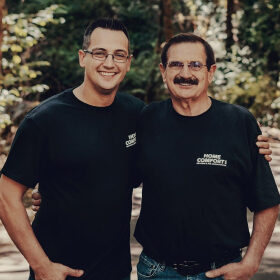In the world of air conditioning, efficiency is rapidly becoming a big part of the decision-making process. Customers want to know that their systems will do the job well without racking up huge energy bills. The nature of AC efficiency is rapidly changing, though, and it’s important to know the big trends so that you can keep up.
Where Advancements Are Happening
High-SEER Units
The Seasonal Energy Efficiency Ratio (SEER) is the gold standard for judging AC efficiency. Higher is better. Modern systems must have a minimum SEER of at least 13.4 for our climate. A SEER2 of 15.2 or higher qualifies as ENERGY STAR. High-efficiency systems are generally SEER 17 or higher.
Ultra-efficient models are becoming popular because utility prices keep going up. Consequently, the payback time for a high-efficiency model may only be seven to 10 years. Especially if you have a large home or business, a high-SEER air conditioner can make a significant difference in your bills.
Inverters and Variable Speed Compressors
A DC inverter is a system that allows a compressor to operate at a range of speeds. These systems offer variable settings rather than operating at maximum capacity in the on position or just turning completely off. They can run at low output levels to maintain cooling once it hits your preferred temperature.
Variable-speed systems with inverters can be 30% to 50% more efficient. Because they don’t have harsh ramp-ups to maximum performance with each cycle, they also reduce wear and tear on the AC. The best inverter-based systems achieve SEER ratings of 20 or higher.
Ductless Mini-Splits
A ductless mini-split is an AC unit that connects one or more indoor air handlers to a single outdoor compressor. Ductless mini-splits are great for adding zoned air conditioning because each room has its own unit. Many models also use heat pump technologies for year-round HVAC.
Ductless designs eliminate the need for the ducting that comes with a central HVAC. This makes them especially appealing for home offices, rental units, and outbuildings. They are also great for home additions and converted garages or attics, especially if you don’t want to get into the difficulty of extending your house’s ducting system. Some folks use ductless mini-splits to retrofit older or historic homes. They are also excellent for small vacation homes, cabins, and lodges.
Smart Technologies
Smart thermostats are rapidly revolutionizing AC efficiency. Modern programmable thermostats allow refined control of temperature and humidity settings. You can develop a schedule for your AC to maximize performance when you’re home and efficiency when you’re away. The top systems even have occupancy sensors and geofencing so that they can always determine when people are present or nearby. This allows the thermostat to ramp up the AC for comfort when you’re returning home.
Most of today’s smart thermostats integrate with many other systems. Phone apps are practically a given, allowing you to control your AC from anywhere. Many systems also integrate with home theaters, voice assistants, home automation, and security setups. This gives you access to the AC controls whether in your home or away.
Some designs even integrate with other automated technologies to improve efficiency. If you have the right type of automated blinds on your windows, a smart thermostat can command them to let sunlight in on cold days or block it on hot ones.
Is AI Making an Impact in HVAC?
Artificial intelligence might be the most significant marketing trend across all tech categories, but it holds serious promise in the HVAC sector. Modern AI can track everything from AC usage patterns to the current price of energy. Some AIs even use weather reports and current energy rates to determine the most cost-effective settings for air conditioning your home.
AI can also track system performance as part of predictive maintenance. By comparing your system’s performance history to manufacturer data, the AI can predict when your AC will likely require repairs or replacement. For example, it might notice a recent uptick in short cycling. This is a sign that a major component, like the compressor, could be struggling. The system can then send a report to your phone telling you to schedule a repair.
Evaporative Systems
Evaporative cooling technology is advancing quickly. A traditional evaporative AC setup uses a wet pad that cools the air. As air flows over the damp pad, the water evaporates. This process is efficient, but tends to increase indoor humidity levels. For this reason, evaporative systems are most popular in dry regions of the country.
Newer evaporative systems use an indirect process. A heat exchanger separates your AC unit from the wet medium. You get all the comfort and efficiency of an evaporative system without the added humidity.
There are also hybrid systems that use a refrigeration setup similar to a traditional AC. The air first flows over the evaporative medium and then across refrigeration coils. This approach achieves both high efficiency and performance. The top evaporative designs may consume 60% to 80% less electricity than a standard AC unit.
How Energy Efficient AC Saves Money
The common theme among most of the trending technologies is waste reduction. Variable-speed controls eliminate wasted energy by avoiding big power ramp-ups. Smart technologies target common inefficiencies, eliminating waste by reducing operations when no one is around or energy prices peak. AI and smart thermostats also allow you to use zoned HVAC more efficiently to target specific areas based on occupancy and unique conditions.
Notably, many of these technologies interact well to create positive feedback loops. Mixing a variable-speed compressor and blower motor with a system that has a smart thermostat, for example, gives the thermostat more ways to maximize efficiency.
Homeowners save money on three fronts. First, increased efficiency reduces electricity bills. Second, reduced wear and tear extends expected system lifespans. Finally, predictive maintenance ensures that worn components are removed before they can cause cascading failures. For example, detecting and fixing a refrigerant leak before it takes out a compressor could save you thousands.
Financial Incentives
Governments, manufacturers, and utility companies increasingly offer a range of financial incentives for adopting high-efficiency AC units. Local, state, and federal governments often offer tax incentives and rebates. It’s a good idea to talk with your accountant or tax preparer to learn what the available incentives may be.
You should also ask your utility provider if they offer rebates or lower rates for adopting specific AC technologies. Some utility companies even offer programs with reduced rates for using AC systems when demand is lowest. Generally, financial incentives target products certified under the federal ENERGY STAR program. Our technicians can guide you to products that meet your energy efficiency and budget goals.
Trust the Local Experts
Home Comfort Inc. works on a wide range of HVAC installation, repair, and maintenance projects, including high-efficiency air conditioners and ductless mini-splits. Our technicians perform jobs for residential and commercial customers. We have been in business since 1954.
If you’re excited about current AC efficiency trends for your home in Dallas, OR or a nearby community, contact Home Comfort Inc. today.

